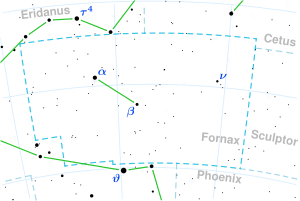Star in the constellation Fornax
For other stars with this Bayer designation , see γ Fornacis .
Gamma Fornacis , a name Latinized from γ Fornacis , is a single star in the southern constellation Fornax . It has a white hue and is faintly visible to the naked eye at night with an apparent visual magnitude of 5.4. The distance to Gamma Fornacis is approximately 520 light years based on parallax . It is drifting further away with a radial velocity of 24 km/s. Gamma Fornacis is a 6th magnitude star about four degrees to the north.
The stellar classification of Gamma Fornacis is A1 V, which is notation for an A-type main-sequence star that, like the Sun, is generating energy through core hydrogen fusion . Comparison of its properties to theoretical models suggest an age of about 400 million years old. It has a high rate of spin, showing a projected rotational velocity of 149 km/s. The star has 2.4 times the mass of the Sun and 4.5 times the Sun's radius . It is radiating 117 times the luminosity of the Sun from its photosphere at an effective temperature of roughly 9,000 K.
References
^ Brown, A. G. A. ; et al. (Gaia collaboration) (August 2018). "Gaia Data Release 2: Summary of the contents and survey properties" . Astronomy & Astrophysics 616 . A1. arXiv :1804.09365 . Bibcode :2018A&A...616A...1G . doi :10.1051/0004-6361/201833051 .Gaia DR2 record for this source at VizieR .
^ Gullikson, Kevin; et al. (2016). "The Close Companion Mass-ratio Distribution of Intermediate-mass Stars" . The Astronomical Journal . 152 (2): 40. arXiv :1604.06456 . Bibcode :2016AJ....152...40G . doi :10.3847/0004-6256/152/2/40 . S2CID 119179065 .
^ Zorec, J.; Royer, F. (2012). "Rotational velocities of A-type stars. IV. Evolution of rotational velocities". Astronomy and Astrophysics . 537 : A120. arXiv :1201.2052 . Bibcode :2012A&A...537A.120Z . doi :10.1051/0004-6361/201117691 . S2CID 55586789 .
^ Houk, N. (1982). Michigan Catalogue of Two-dimensional Spectral Types for the HD stars. Declinations -40_ƒ0 to -26_ƒ0 . Vol. 3. Bibcode :1982mcts.book.....H .
^ Anderson, E.; Francis, Ch. (2012). "XHIP: An extended hipparcos compilation". Astronomy Letters . 38 (5): 331. arXiv :1108.4971 . Bibcode :2012AstL...38..331A . doi :10.1134/S1063773712050015 . S2CID 119257644 .
^ Gontcharov, G. A. (2006). "Pulkovo Compilation of Radial Velocities for 35 495 Hipparcos stars in a common system". Astronomy Letters . 32 (11): 759–771. arXiv :1606.08053 . Bibcode :2006AstL...32..759G . doi :10.1134/S1063773706110065 . S2CID 119231169 .
^ McDonald, I.; et al. (2017). "Fundamental parameters and infrared excesses of Tycho-Gaia stars" . Monthly Notices of the Royal Astronomical Society . 471 (1): 770. arXiv :1706.02208 . Bibcode :2017MNRAS.471..770M . doi :10.1093/mnras/stx1433 .
Anders, F.; et al. (2019). "Photo-astrometric distances, extinctions, and astrophysical parameters for Gaia DR2 stars brighter than G = 18". Astronomy and Astrophysics . 628 : A94. arXiv :1904.11302 . Bibcode :2019A&A...628A..94A . doi :10.1051/0004-6361/201935765 . S2CID 131780028 .
"gam02 For" . SIMBAD Centre de données astronomiques de Strasbourg . Retrieved 2021-01-17.Eggleton, P. P.; Tokovinin, A. A. (September 2008). "A catalogue of multiplicity among bright stellar systems" . Monthly Notices of the Royal Astronomical Society 389 (2): 869–879. arXiv :0806.2878 . Bibcode :2008MNRAS.389..869E . doi :10.1111/j.1365-2966.2008.13596.x . S2CID 14878976 .
Sinnott, Roger W.; Perryman, Michael A. C. (1997). Millennium Star Atlas . Vol. 1. Sky Publishing Corporation and the European Space Agency. p. 381. ISBN 0-933346-84-0
Categories :
Text is available under the Creative Commons Attribution-ShareAlike License. Additional terms may apply.
**DISCLAIMER** We are not affiliated with Wikipedia, and Cloudflare.
The information presented on this site is for general informational purposes only and does not constitute medical advice.
You should always have a personal consultation with a healthcare professional before making changes to your diet, medication, or exercise routine.
AI helps with the correspondence in our chat.
We participate in an affiliate program. If you buy something through a link, we may earn a commission 💕
↑
